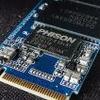Specifications & Features
Features
MP33 PRO M.2 PCIe Solid State Drive adopts PCIe Gen3x4 high-speed interface and highly compatible M.2 2280 specification. The maximum read/write speed can reach 2,100/1,700MB/s, and the random read/write capacity of 4K IOPS 220,000 can greatly increase the efficiency of data processing. A large capacity of up to 2TB is released for professional users, which can meet the needs of creators and gamers who need large amounts of storage space for their material. And the built-in smart algorithm management mechanism can ensure operation efficiency, speed and data storage stability.
TEAMGROUP MP33 PRO PCIe SSD Specifications
| Model | MP33 PRO M.2 PCIe SSD |
| Interface | PCIe 3.0 x4 with NVMe 1.3 |
| Capacity | 512GB / 1TB / 2TB |
| Voltage | DC +3.3V |
| Operation Temperature | 0C ~ 70C |
| Storage Temperature | -40C ~ 85C |
| Terabyte Written | 512GB (400TB) 1TB (600TB) 2TB (1000TB) |
| Performance | Crystal Disk Mark: Read/Write: up to 2,100/1,700 MB/sIOPS: Read/Write: 220K/200K IOPS Max |
| Weight | 6g |
| Dimensions | 80(L) x 22(W) x 3.8(H) mm |
| Humidity | RH 90% under 40°C (operational) |
| Vibration | 80Hz~2,000Hz/20G |
| Shock | 1,500G/0.5ms |
| MTBF | 2,000,000 hours |
| Operating System | System Requirements: Windows 10, Windows 8.1, Windows 8, Windows 7, Windows Vista Linux 2.6.33 or later |
| Warranty | 5-year limited warranty |
Phison PS5013-E13 controller
The SSD is making use of a PS5013-E13 controller from Phison which we do not see that often. It makes use of the NVMe revision 1.3 protocol. As you have been able to notice from the SSD specifications, this controller is working across its four PCIs for read and write operations respectively, over an x4 PCIe Gen 3 lane connection that is. The controller can work with 64GB upwards to 2TB capacities but is more limited in performance. For 4K random read and write operations, the controller can perform up to 295K operations per second (IOPS)reads and 430K writes. It is compatible with TLC / QLC and 96-layer NAND.


